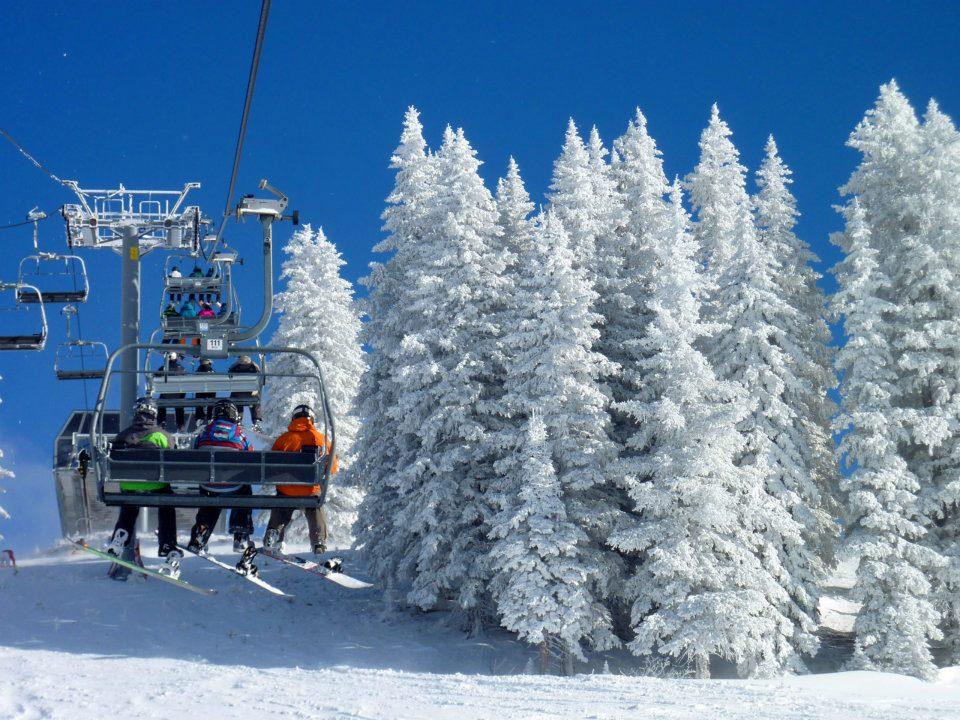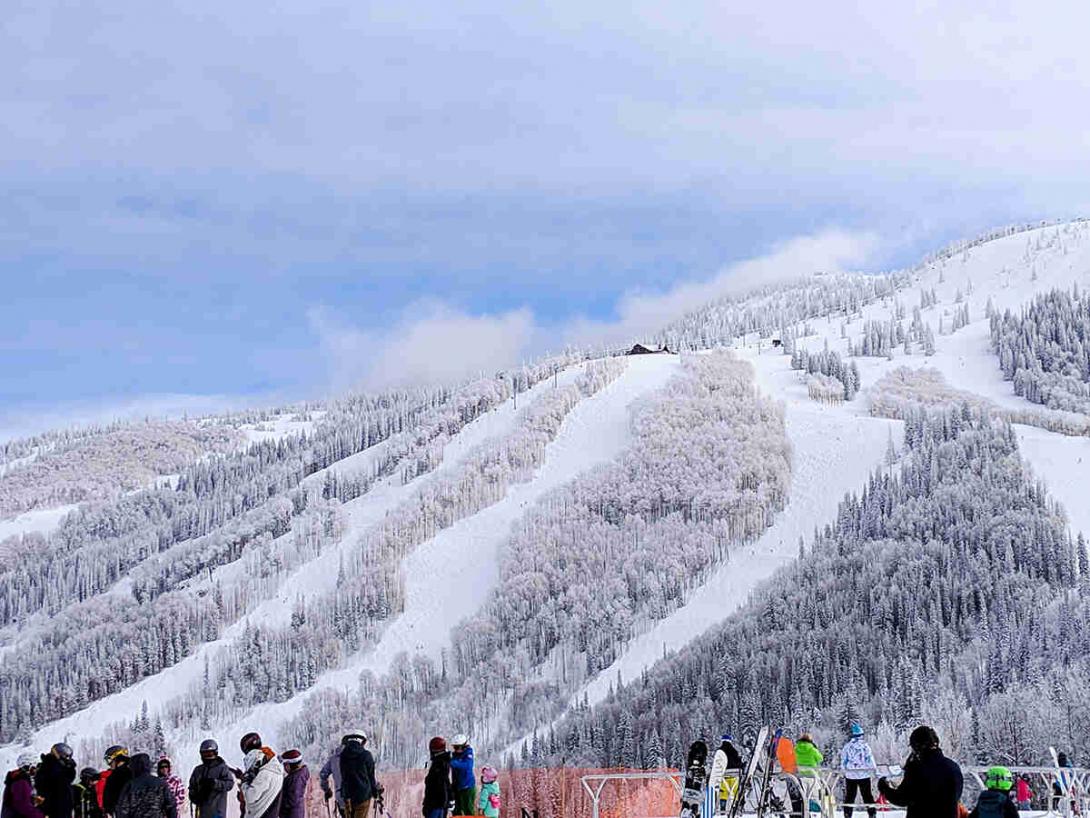Ski Industry
Full Article
Colorado’s ski industry anchors the state’s thriving tourist economy. Built primarily on national forest lands, the state’s numerous ski resorts attract upwards of 12 million visitors annually, generating billions in revenue. Introduced to the state in the late nineteenth century, downhill skiing’s popularity drove the rapid development of Colorado’s mountain communities following World War II. Such growth, combined with concerns over wildlife and air and water quality, placed the ski industry at the center of ongoing debates over development in mountain environments. Today, skiing continues to define Colorado’s high country.
Early History
Gold prospectors first brought skiing to the Colorado Rockies beginning in the 1860s. Using skis, mail carriers such as “Father” John Dyer dared the high mountain passes and heavy winter snows, traveling between the region’s isolated mining communities. By the end of the century, skiing was an integral part of the culture in mountain towns such as Crested Butte and Steamboat Springs. Skiing continued to grow in popularity in the opening decades of the twentieth century, with winter carnivals such as the one held in Hot Sulphur Springs in 1911 that drew thousands. In 1921 the newly formed Denver Ski Club hosted the National Ski Tournament of America Championship at Genesee Mountain outside of Denver. Thousands soon took up the sport, leading to the construction of dozens of small rope-tow ski hills throughout the state.
Federal Support
The US Forest Service became intricately involved in the development of ski areas with the opening of Berthoud Pass in the 1930s. The pass first drew the attention of skiers when the Colorado Department of Highways began plowing US Highway 40 in 1931. Skiers soon took advantage of the easy access to snow-covered slopes on either side of the highway as it crested the Continental Divide. But a lack of facilities, including adequate shelter, led to a demand for greater development. The US Forest Service responded by placing an aging military barracks on Berthoud’s summit to act as a ski lodge. Six years later, The May Company, a Denver department store, financed the installation of the state’s first rope tow at Berthoud. This collaboration between federal and private interests set the precedent for the future development of the ski industry throughout the state.
Berthoud Pass was not the only ski area to open in Colorado during the 1930s. Aspen locals cut the Roche Run on the side of Ajax Mountain outside the mining town in 1938. The following year the first ski lift in the state was built at the small ski hill, Cement Creek, near Gunnison. But it was Denver’s opening of Winter Park at the western portal of the Moffat Tunnel in 1940 that linked the future of skiing to Colorado’s growing urban population along the Front Range.
The United States’ entry into World War II slowed the development of new ski areas in the state. Yet, the stationing of the US Army’s newly formed Tenth Mountain Division at Camp Hale near Leadville in 1942 proved instrumental in the industry’s postwar growth. Veterans of the famed division played a significant role in developing the Colorado ski industry, founding such resorts as Vail and Snowmass, operating dozens of ski schools, and opening countless other businesses integral to the sport’s popularity. Between 1945 and 1947 the number of skiers jumped 75 percent statewide, starting a twenty-year boom in the construction of new ski areas that pumped millions of dollars into the state and local economies.
Growth and Controversy
The opening of Vail in 1962 marked skiing’s emergence as a major player in Colorado’s economy. The combination of skiing and real estate proved a potent mixture. But as ski areas were transformed into ski resorts, complete with lodging, restaurants, and real estate, Colorado’s once isolated rural communities became a sprawling urban corridor along the newly constructed Interstate 70, further connecting Colorado’s mountains with a rapidly growing Front Range. While celebrated as an economic boon by state boosters, increasing numbers of Coloradans began to worry about the impacts of such rapid growth on their quality of life. Such concerns came to a head with the selection of Denver as the host of the 1976 Winter Olympics.
The Olympic controversy focused attention on the US Forest Service and ski industry’s role in fostering rural growth. After three years of struggling to locate an adequate site for the events, the Denver Olympic Committee selected Beaver Creek, immediately throwing the proposed ski resort into the center of the Olympic controversy. Beaver Creek and other resorts, including Lake Catamount and Marble Mountain, became targets of criticism for their potential impacts on the region’s environment and quality of life. Colorado voters rejected the Olympics in 1972, bringing an end to a nearly thirty-year boom in ski resort development within Colorado.
Corporate Consolidation
The ski industry faced changing economic and regulatory realities during the 1980s. Increased competition led to an arms race among the state’s ski resorts over which one could provide the most terrain, fastest chairlifts, and most extravagant amenities to attract larger market shares of skiers and snowboarders. Apollo Management’s purchase of Vail Associates in 1987 led to an intense period of consolidation. The newly formed Vail Resort’s merger with St. Louis-based Ralcorp Holdings, Inc., owners of Breckenridge, Keystone, and Arapahoe Basin ski resorts, made the corporation the largest ski resort owner in Colorado, controlling nearly 40 percent of the state’s ski market. At the same time, Canadian resort giant Intrawest gained controlling interests in Copper Mountain and Winter Park, and the American Ski Company purchased Steamboat Ski Resort. Smaller ski areas struggled to compete with larger, amenity-driven resorts, leading to broader criticisms of the industry and the US Forest Service.
With the industry’s consolidation as the backdrop, Vail’s decision to move forward with its planned Category III expansion drew national attention when members of the Earth Liberation Front set fire to the resort’s Two Elk Lodge, Ski Patrol Headquarters, and several other buildings in protest of the resort’s expansion into the habitat of the threatened Canada lynx. The arsons underlined the continued tensions over the ski industry’s economic and environmental impacts. In response to such criticisms, many Colorado resorts joined the National Ski Area Association’s Sustainable Slopes Program in creating a framework of environmental principles, including sustainable planning, optimal water use, and reduction of greenhouse gases.
Today
Throughout the opening decade of the twenty-first century, Colorado remained the most popular destination for skiing in North America, attracting more skiers and snowboarders than any other state. Concerns over growth and wildlife habitat remain, but skiing will undoubtedly play an integral role in the future of Colorado’s mountain regions.

































































